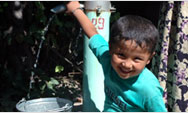Avian Influenza Response: Key Actions to Date
| |
 |
|
|
|
 |
| |
Participants march in an event organized by the Laos Women’s Union (LWU) in Vientiane, Laos, to show their support in the fight against avian influenza. Several officials, including governors of districts affected by outbreaks, participated in the event. USAID has provided assistance to local organizations such as LWU to help educate community members about the disease, and has also launched mass media campaigns to generate more awareness. Source: Academy for Educational Development |
|
|
|
|
|
|
The U.S. Agency for International Development (USAID) recognizes the highly pathogenic H5N1 avian influenza (AI) virus as a threat to public health, economic stability, and development in affected countries. Experts fear the virus could mutate into a form capable of causing a human influenza pandemic. To help combat AI and mitigate a potential human pandemic, USAID is fully engaged in the U.S. Government’s (USG’s) efforts to ensure a well-coordinated and strategically sound response to help contain AI in animals and limit its spread to humans, thus lessening opportunities for the virus to mutate. In addition to coordinating with USG partners, USAID works closely with host governments and international and private-sector partners, including the World Health Organization (WHO) and the United Nations Food and Agriculture Organization (FAO), to support AI interventions.
Overview: USAID Funding for Avian Influenza Activities
USAID provides AI assistance in nearly 90 countries. Working with its partners, USAID supports AI programs through regional platforms, USAID Missions, nongovernmental organizations (NGOs), and international organizations. Largely through grants and technical assistance, the Agency has committed more than $191 million in foreign assistance for AI and pandemic preparedness.
USAID has committed $14 million and $23 million of its AI funds for activities with WHO and FAO, respectively, and $78 million for AI activities in countries affected by the virus. Of this $78 million, $46 million is for efforts in Asia and the Near East, $19 million is for Europe and Eurasia, $11 million is for Africa, and $2 million is for Latin America and the Caribbean. Additionally, USAID manages a $56 million commodity stockpile that includes essential goods such as personal protective equipment (PPE) for surveillance and outbreak response workers, decontamination equipment, and laboratory specimen collection kits.
In May 2007, USAID received an additional $161 million to further its AI efforts. These funds will be invested to build upon USAID’s ongoing AI successes and expand the geographic focus of AI programs that help reduce the potential for a pandemic-capable strain of the virus to emerge. In addition, these funds will be applied toward strengthening countries’ pandemic readiness [PDF, 83KB], including building capacity for management of a humanitarian response in the event of a global influenza pandemic.
To support countries affected by and at high risk for AI outbreaks, USAID provides assistance in five key areas: planning and preparedness, surveillance and case detection, communications, commodity stockpiling, and emergency outbreak response.
- Planning and preparedness
USAID supports national planning and preparedness for AI control and outbreak response in 57 countries. In collaboration with WHO, FAO, and other partners, USAID works with the governments of these countries to develop and support national AI task forces and preparedness activities. This assistance includes strengthening overall coordination of these efforts. In addition, USAID works with WHO and FAO to conduct simulations that test national preparedness plans. These simulations help identify weaknesses in plans and highlight areas that require additional effort.
- Surveillance and case detection
USAID works with its partners to improve disease surveillance and diagnostic capacity for rapid detection of AI in animals and humans in affected countries. In Indonesia, where AI is endemic in poultry, USAID supports a community-based surveillance approach, and has mobilized participatory disease surveillance and response (PDS/R) teams in 188 districts across Java (113), Bali (9), Kalimantan (19), Sulawesi (14), and Sumatra (33) to routinely visit villages and collect essential surveillance data and samples for laboratory analysis. In total, 2,438 Indonesians currently work in the field in 598 PDS teams, 593 PDR teams, and 28 combined PDS/R teams. USAID also works with partners through the Global Avian Influenza Network for Surveillance (GAINS) to increase surveillance of wild migratory birds and track the movement of AI globally. GAINS contributors work in 28 countries around the world, conducting mortality surveillance, AI sampling, and wild bird censuses. Through GAINS, more than 10,000 samples have been collected for H5N1 analysis and census data from nearly 103 million bird observations are being made available via an open database and mapping system. During its first year, the GAINS program also trained more than 800 people in wild bird handling, sampling, and/or data collection related to controlling the spread of H5N1 AI.
Data gathered in surveillance activities increase the availability of scientific information about the H5N1 AI virus, including whether genetic changes have occurred that could increase its threat to humans. This information is also applied to support early-warning systems, which help notify at-risk countries about the movement of AI and its potential spread. For example, GAINS releases confirmation of high pathogenic AI-positive test results within 24 hours so alerts can be disseminated.
- Communications
USAID supports AI-related communications and public outreach activities in 47 countries and works with its partners to provide trainings for journalists. Messages conveyed through mass media and community-level outreach to rural populations help generate public awareness and promote behaviors that reduce risks for disease transmission. In Laos and Cambodia, USAID has created Super Chicken, an extremely popular character who disseminates risk-reduction messages through animated public-service announcements on television and appearances at a variety of community events.
- Commodity stockpiling
Since January 2006, USAID has built a stockpile of 1.5 million sets of PPE, 100 laboratory kits, and 15,000 decontamination kits for use in surveillance, outbreak investigation, and emergency outbreak response and containment. To date, USAID has deployed more than 300,000 PPE kits to more than 70 countries for these efforts.
- Outbreak response
USAID works with its partners to strengthen animal and human H5N1 AI response efforts across the globe. Activities include promotion of safe culling and disposal procedures and improved biosecurity practices in poultry-raising settings. USAID also supports trainings for first responders in AI-affected countries on the proper use of PPE, how to collect and ship samples, and how to detect AI using laboratory diagnostic equipment. In Indonesia, USAID supports efforts of participatory disease response (PDR) teams, which use critical disease information supplied by the community-level PDS teams to quickly identify poultry infections and work with farmers and local governments to implement rapid response and containment measures during outbreaks.
Latest News and Resources on the USAID Response
- U.S. International Avian and Pandemic Influenza Assistance Approaches $950 Million - 10/25/08
- USAID Continues to Bolster Sri Lanka’s Defense Against Avian Influenza - 10/09/08
- USAID, Agriculture and Health Professionals of the Central Asian Countries Discuss Potential Highly Pathogenic Avian Influenza (HPAI) Pandemic Preparedness - 09/30/08 [PDF, 34KB]
- USAID Has Launched Its Stamp Out Pandemic and Avian Influenza (STOP AI) Project in Central Asia - 09/17/08 [PDF, 31KB]
- Campaign Keeps Avian Flu at Bay - 07/03/08
- U.S. Enhances Azerbaijan’s Preparedness and Capacity to Face Outbreaks of Avian Influenza - 07/01/08
- USAID Supports Sri Lanka’s Efforts Against AI - 06/25/08
- Regional Experts and Governments Cooperating to Battle Avian Influenza Outbreaks - 06/09/08 [PDF, 36KB]
- USAID Launches Region's First Avian Influenza Regional Distribution Center in Thailand - 03/18/08
- USAID Mourns the Loss of Steve Wilbur, Director of USAID | DELIVER Project's Avian Influenza Task Order - 02/25/08
- U.S. Provides Additional Funding for Avian Flu Fight in India - 02/21/08
- USAID Donates More Equipment to Help Fight Spread of Avian Influenza in Pakistan - 01/23/08
- "Substantial Progress" in Global Avian Flu Response, Report Says - 12/04/07
- Nations Examine Pandemic Flu Preparedness at India Conference - 12/03/07
- U.S. Government Provides an Additional $10.5 million to Vietnam for Avian and Pandemic Influenza Prevention and Control - 11/07/07
- USAID Continues to Strengthen Avian Influenza Surveillance and Response in Turkmenistan - 09/18/07 [PDF, 48KB]
- Food and Agriculture Organization (FAO) Develops Community-Level Avian Influenza Surveillance in Indonesia with USAID Support - 07/26/07
- The U.S. Government, through USAID, to Provide up to $24 Million in AI Support to Egypt Over the Next Three Years - 07/01/07
- Report: U.S. Leads Avian Influenza Efforts - 06/21/07
- Fact Sheet: USAID: Investing in People - 05/31/07
- USAID Donates Avian Influenza Protective Gear To Pakistan - 05/01/07
- USAID Bolsters International Avian Influenza Response - 03/30/07
- USAID to Strengthen Delivery of Avian Influenza Commodities Globally - 03/30/07
- U.S. Officials Offer Pandemic Flu Aid in Egypt, Switzerland - 02/23/07
- U.S. Ambassador to Indonesia Presents Protective Gear to Aid in the Battle against Avian Influenza - 01/26/07
- United States Announces Additional Donation to Food and Agriculture Organization (FAO) Emergency Programs - 10/11/06
- Statement on Avian Influenza from Randall L. Tobias, Director of U.S. Foreign Assistance and USAID Administrator - 09/21/06
- The U.S. Provides an Additional $3.2 million to Indonesia for Avian Influenza Prevention - 09/15/06
- Fact Sheet: USAID Advances U.S. International Engagement on Avian Flu - 06/16/06
- USAID Announces $5 Million Award to Enhance International Efforts to Track Avian Influenza - 06/09/06
The Global Avian Influenza Network for Surveillance (GAINS) will enhance international efforts to collect and analyze laboratory samples from wild birds and identify genetic changes in the virus.
Related USAID Programs
Additional Information on Avian Influenza (Bird Flu)
|


